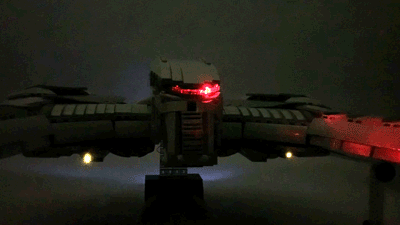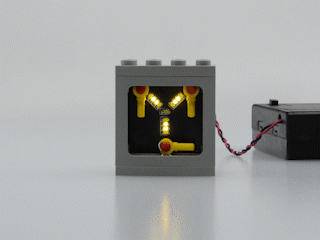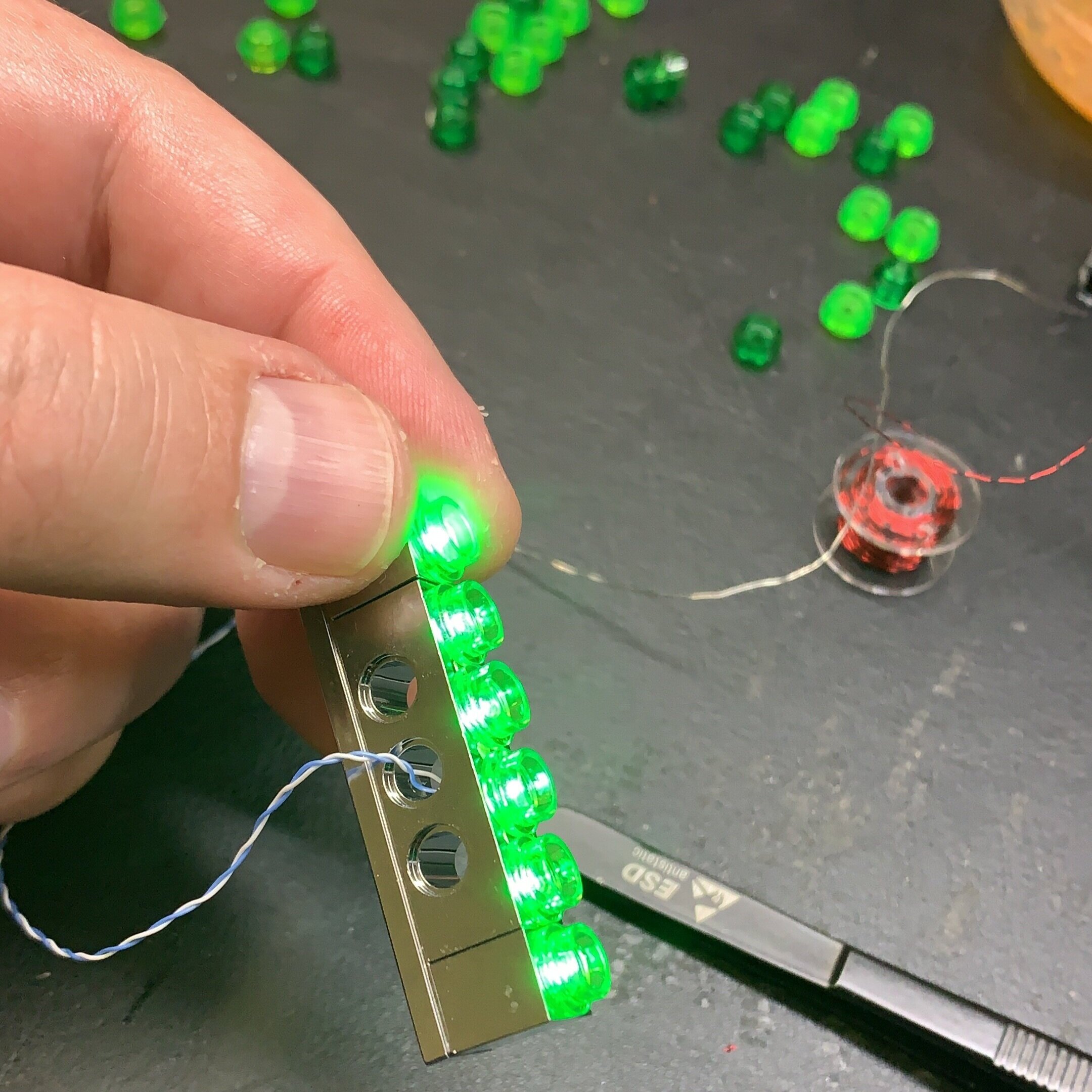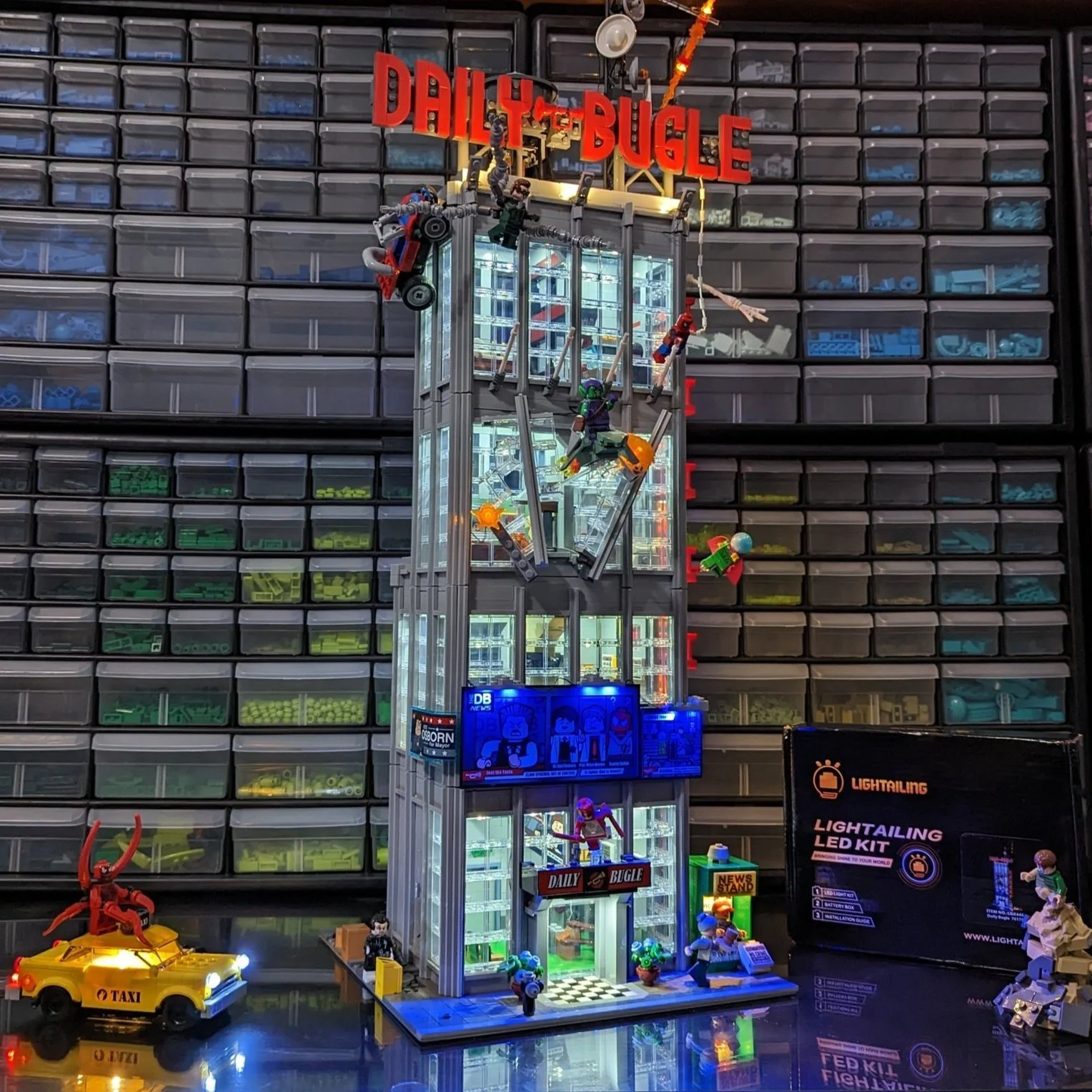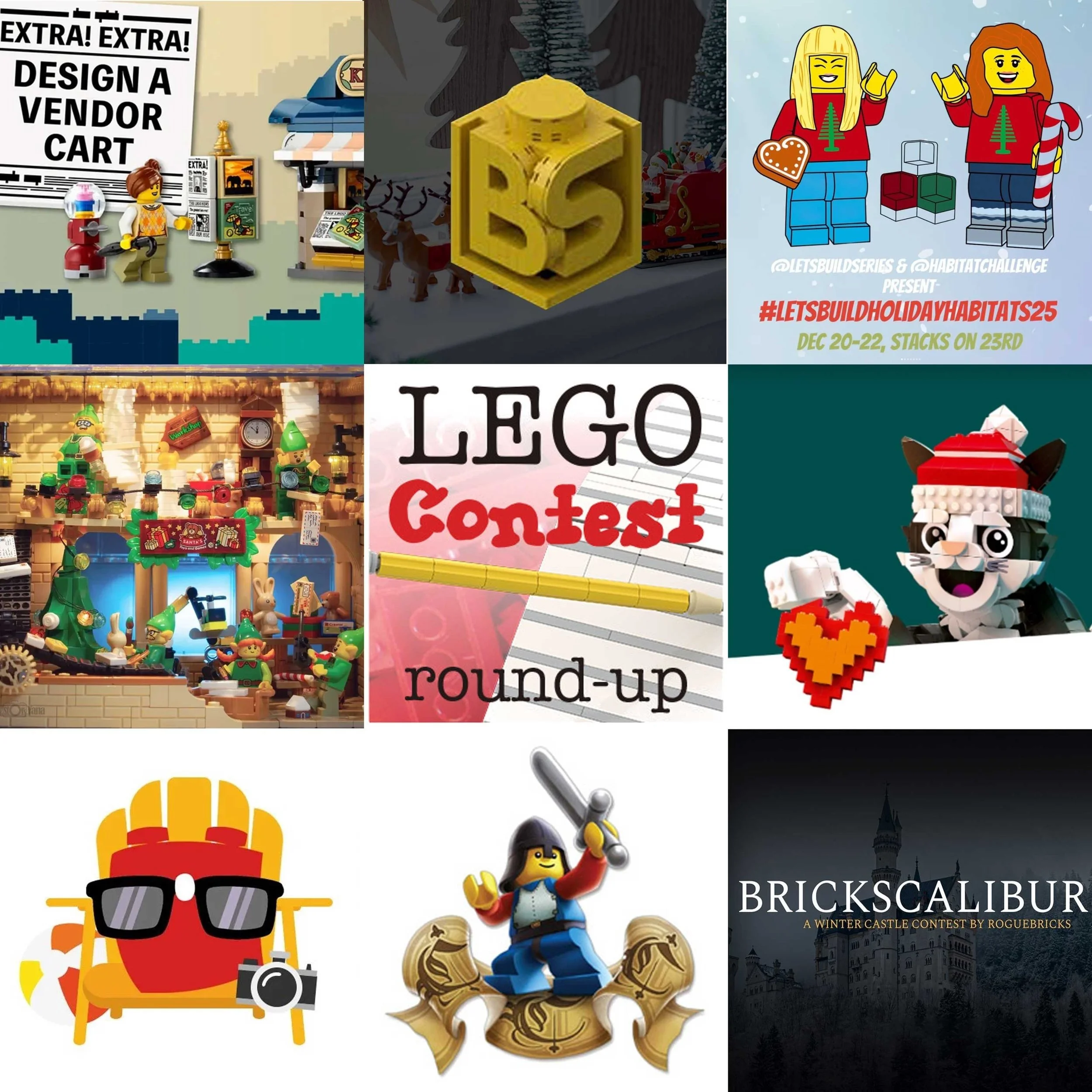Beyond Lights: Taking Your LEGO Builds to the Next Level
/Best of BrickNerd - Article originally published July 23, 2021.
Today’s article on LEGO lighting was written by Rob Klingberg, Chief Enthusiast of Brickstuff. Rob is a fixture in the AFOL community and has continually helped advance what lighting is capable of in LEGO builds—custom creations or sets. At the end of the article, he also announces a new effort that will help all lighting solutions come together—just like he helps the LEGO community come together.
A World of Lights
It happens about every two months: I’m catching up with my social media and BAM! Another Facebook, Twitter, or Instagram ad appears for some new company selling lights designed for LEGO models. I’m going to date myself here, but it seems a little like that scene from the 1967 film The Graduate, where an older businessman takes a young Dustin Hoffman aside at a party and shares what he believes is the secret to future business success. “I just want to say one word to you,” the businessman says. “Just one word: PLASTICS. There’s a great future in plastics. Think about it.”
LEGO Harry Potter Beauxbatons' Carriage (Set 75958) with flickering Pico LED lights. (Brickstuff animated gif)
When I see one of the ads for another new company selling lights, I always hear that scene in my head. It’s like the people starting these companies are Dustin Hoffman at that same party, though the businessman says something slightly different this time. “I just want to say four words to you. Just four words: Lights for LEGO sets. There’s a great future in lights. Think about it.”
When I started Brickstuff 10 years ago, there were only two other companies selling aftermarket lights for LEGO models: LifeLites and BrickCircuits (the former is still going strong, while the latter has been on hiatus for many years). Brickstuff was the third company to enter the fray, and in those days, it was unusual for LEGO builders to add lights to their sets or MOCs. Back then, the process of adding lights to a model seemed like some sort of dark art.
There were people who would magically appear at conventions such as Brickworld Chicago that featured a “World of Lights” event where the venue would turn off its lights at night and let convention-goers wander through darkened halls lit only by the pinpoints of tiny LED lights. These wizard AFOLs of electronics would showcase their incredible models, leaving the uninitiated to ponder by what work of sorcery mysterious components like resistors, rectifiers, and grain-of-wheat bulbs were wrangled into the amazing displays on show.
I started the company because I wanted to make lights anyone could install, in any build, no matter how small. I wanted to shed light on the “dark art” of LED lighting for LEGO models, so that every builder could add that “wow” factor to their creations. We were the first to offer lights with small plugs (we call them Pico connectors) and thin wires, a configuration that has since been adopted by most other companies offering lighting products. Looking at the range of lighting products available to the AFOL these days, I’m amazed; it has never been easier to get started with lighting.
From Small to Big: Finding Inspiration
I’ve always believed in creating the highest-quality products possible, and one of the differences between Brickstuff and most of the other lighting companies continues to be our focus on innovation. We are always looking for ways to bring the latest innovations in the consumer electronics and technology industries into the products we make and sell around the world. Because we make most of what we sell in our small offices in Rosemount, Minnesota, USA, we can experiment with the latest technologies and see how they fit into new sets designed by AFOLs or produced by LEGO.
I have bins full of failed prototypes in my design lab—at least 100 different designs we have tried but which haven’t worked out quite right. Pushing the envelope like this does allow us to do some amazing things, though, like when we created the smallest portable power source and the smallest LED lights that could fit underneath any LEGO part. Using these elements, we were able to add almost 10 lights to the mini London Bus from 2016.
Mini London Bus (LEGO Set 40220) with lights and battery pack installed. (brickstuff photo)
This was an early proof of concept, and it led to the development of light kits we will soon be rolling out for the LEGO Speed Champions line of vehicles. The goal here was to make everything as small as possible so you could continue enjoying your model and playing with it without having to worry about seeing wires or having an external battery pack. I wanted to prove that you could light up any model, no matter how small.
While going small is good, I also wanted Brickstuff technology to scale to support the largest installations, all while using the same standard parts. Just like you can build small with LEGO, you can also build REALLY big, and I wanted our lights to support that enormous range of possibilities.
We got our chance to put our ideas to the test in 2015, when we were approached by AFOL Harry Nijenkamp in Atlanta, Georgia, USA. Building with his son Austin, Harry created a city on a massive scale: more than 300 square feet in size (27.9 sq m), over two million bricks, more than 100,000 minifigures, skyscrapers that were 14 feet (4.25 m) tall, and—we would soon learn together—more than 1,000 lights.
Harry’s city, which you can still see on this YouTube video from 2015, was the centerpiece at a fan convention held in Atlanta in October 2015 called Celebricktion. Harry’s city remains the largest single installation of LEGO lighting in history, and we worked hard to make custom streetlamps, a custom color-changing LED light strip, and many other unique elements to bring his vision to life.
Harry Nijenkamp’s city at night at the Celebricktion show. That’s BrickJournal’s Joe Meno in the lower right corner. You have to look twice to realize you’re not looking at a real city. (Brickstuff photo)
More photos of the setup are on our Flickr page. The Celebricktion city is still one of my favorite projects, and because of Harry always asking “can we do this?” to push the envelope, it got me thinking well beyond basic lighting.
I’m lucky in my job because I get e-mails and social shares from customers who have created worlds using our products that I could have never imagined. One of my favorites was shared on our User Forum by customer @nolphi_plays: a LEGO Christmas village unlike any I had seen before.
Photo of Christmas village with Brickstuff lights, posted by @nolphi_plays, taken from the Brickstuff User Forum.
The village looks amazing, but what’s even more incredible is that the family sets it up anew each year, building it into a different design.
Custom Lighting for Creative Customers
This Christmas village was completely designed and built by the customer without any custom lighting parts from us, but something else that sets us apart from other companies is the amount of custom work we do take on. One of my favorites from last year was a custom chandelier designed by well-known Belgian AFOL @kinglouiebricks for his massive Louietown Central Station. I hand-wired 25 Pico LED lights into the chandelier, a process that took a long time but which was so gratifying to see when mounted in his beautiful station.
Making the chandelier for Louietown’s Central Station. A lot of wire for 25 lights! (brickstuff photo)
The final result: the chandelier mounted inside the Louietown Central Station and looking amazing. Photo courtesy of @kinglouiebricks.
It’s no secret that the number of AFOL-designed models has exploded in recent years, and working with these talented people is another great source of pride for us. When sci-fi AFOL designer David Duperron (@davdupmocs) approached us asking to create a light kit for his amazing Cylon Raider from the Battlestar Galactica series, it pushed us to our limits to design a real moving “eye” with nine lights built on a flexible circuit board and pre-installed inside a transparent red round 4x4 LEGO plate with 2x2 hole. I can’t even remember how many prototypes I went through to get this one working, but the end result was exactly what David had in mind.
Close-up and final installed view of the Cylon “eye” created for David Duperron’s Cylon Raider. (Brickstuff animated gifs).
We’ve since adopted this same technology to re-create the infamous “Larson Scanner” from the KITT car in the 1980s TV series Knight Rider, designed to fit a Bluebrixx model.
The final flux capacitor with animated LED lights, designed for Dave Slater’s DeLorean Time Machine.
Speaking of famous vehicles, last year we worked with designer Dave Slater to make an animated flux capacitor for his incredible DeLorean Time Machine MOC from Back to the Future. This project pushed our limits of creating flexible circuits, and once again, I can’t remember the number of prototypes it took to get this one working just right. The result is mesmerizing.
Another long-time collaboration has taken place since 2016 with well-known Dutch AFOL Dennis Glaasker (@bricksonwheels). Dennis builds some of the most mind-bending transportation models imaginable, and I know we’re in for a challenge whenever Dennis sends us a photo or drawing of his latest project.
We had the chance recently to develop custom lighting for his amazing Peterbilt dump truck (you can see the photo gallery here). Working with this project was especially tricky because Dennis and builders like him use many chromed parts; these present special challenges because the metal surface of the parts can cause electrical short-circuits if the lighting is not properly designed.
Testing the custom lights for Dennis Glaasker’s Peterbilt dump truck. (Brickstuff photo)
I love that each of these projects pushes us beyond our limits to create unique things you can’t find anywhere else. Since I am entirely self-taught on electronics, programming, and circuit board design and assembly, this process is hugely satisfying for me. Not a day goes by when I don’t learn something new, and I work as hard as I can to turn that knowledge into new products that continually raise the bar in terms of what people can expect from lighting solutions.
A Hands-On Approach: Assembly and Production
I hand-assemble all of our prototypes, and I use our small automated assembly machine to make many of our production parts. The photo below shows a panel of adapter boards for our Disney Castle light and sound kit in the process of being auto-assembled.
With a little help from our robot friends: Assembling a panel of lighting adapters. (Brickstuff photo)
After assembly, it’s into the oven where the solder melts and the parts become permanently attached to the circuit boards.
Cooking up a fresh batch of color-changing lights for our Disney Castle fireworks cubes. (Brickstuff photo)
Making many of our products ourselves in our office allows for tight quality control, and because parts are made in small batches, we can add the latest technology to our designs quickly.
While having automated manufacturing help is handy, we also make a lot of our parts by hand. When I designed the system for our light kit for the LEGO Bugatti Chiron, because of the huge range of lower-priced options in the market at the time, I knew I had to create something special. Something with as much “wow” factor as you could fit into a scaled-down Bugatti. We created the only animated headlights on the market, and to get the most realistic look, I made each headlight assembly by hand for every kit we sold.
Bugatti headlight assembly: eight LED lights hand-mounted inside four 1x1 LEGO plates. I really had to monitor my coffee intake on these days to keep a steady hand! (Brickstuff photo)
Once again, the end result was exactly what I’d hoped for: something that would turn people’s Bugattis into showpieces. While we no longer offer this kit for sale, it remains one of my favorite projects, and we’ve since incorporated its technology into several other kits.
Bugatti animated headlight sequence (Brickstuff animated gif)
If you look closely at the photo above, you can see a fiber optic tube inside the Bugatti between the driver and passenger seat: this is taken directly from the design of the real-world vehicle. While the Bugatti kit used fiber optic tubing with a light at the end, we looked for many years to find a solution that would be brighter, like neon.
There’s the obvious use case here: TRON builds. But enough customers requested something like this that we partnered earlier this year with a manufacturer to develop flexible LED filament in several different colors. This is like the parts found inside retro “Edison”-type light bulbs for home use but scaled down in size and voltage for use with LEGO.
Flexible filament LED light, blue color. (brickstuff animated gif)
We’ve had this product for sale on our site for several months, and already customers have found uses for the parts we could have never dreamed of. Interestingly, the filament is just thin enough to fit between the groves of the standard 1x2 LEGO grille piece, which opens up loads of creative potential.
Once we started looking for suppliers of the LED filament, we found companies making flexible neon LED tubing, and one of my first thoughts was: docking bay 327 on the Death Star. This is a hugely popular fan build, originally posted on Rebrickable, and a model that has occupied more than a little space in the Brickstuff design lab for a long time. Recently I received samples of the neon LED tubing to test out in the docking bay opening, and the results look promising.
Sample LED neon tubing mounted around the opening of the Docking Bay 327 MOC. (Brickstuff photo)
We’re going to incorporate this technology into our upcoming light and sound kit for the docking bay, and we’re already getting overwhelmingly positive fan feedback on the design. What I love most about the way this looks is that, if you ignore the colorful LEGO bricks attached to the base and the plastic bags, it really does look like the Death Star from the original Star Wars films.
Beyond the Basics
One of our strongest beliefs at Brickstuff is that the building doesn’t end when your LEGO set is assembled. Every set looks better with lights, and adding lights to any set should be something that transforms both the building experience and the final result into something greater than the sum of its parts.
Just as lights can transform a LEGO set, there is so much more you can do with your lights after installing them. I created the original Brickstuff lighting system design in late 2010 when my children began building and playing with the LEGO Modular Building series of sets. I’d “borrow” one of these sets and experiment with different ways to add and connect lights, and eventually, I designed a system that worked well.
Or at least I thought it did. I soon discovered that my “improvements” made it harder for my kids to play with their sets because of all the wires that ran between buildings and between floors. From an adult point of view, the setup was perfect, but my kids just wanted to open up the floors and move buildings around.
Several years later, when we began collaborating with LEGO User Groups (LUGs) around the world, we heard a similar request: LUGs need to quickly connect and disconnect lighting when transporting their layouts and cities, so having wires to plug and unplug slowed things down. Once again, after more prototypes than I can count, we released the first plug-less horizontal and vertical connectors designed for use with LEGO.
Plug-less horizontal power connectors in action. (Brickstuff animated gif)
Plug-less vertical power connectors in action. (Brickstuff animated gif)
Another request that came specifically from the LUGs was the ability to turn power on and off without needing to open up a build and access a power switch. In response, we created a miniature magnetic switch that could be placed under LEGO plates and activated with a tiny magnet placed inside the leg of a minifigure—or in the case of the Fallingwater LEGO Architecture set, in the trunk of a tiny tree.
Lights turned on and off using a mini magnet and hidden switch. (Brickstuff animated gif)
I love these solutions because of their simplicity and ease of use, but also because they open the world of lighting to new groups of fans. They show how easy it is to create more than just a static lighting setup.
Speaking of models not being static, when we got our hands on the Creator Expert Ecto-1 set in late 2020, we saw an opportunity to offer something we’d never offered before: a remote-controlled motor in addition to light and sound. It took a little wrangling, but in the end, customers have cited this motion feature as one of the main reasons they bought a Brickstuff kit for their Ecto-1.
Automatically scanning for ghosts: just press a button on the remote for our Ecto-1 light and sound kit. (Brickstuff animated gif)
Building on our experience designing these types of add-ons, we’ll soon be releasing a line of automatic timers (based on requests from customers who want to use their Disney Castle or LEGO Treehouse as a night light for their kids—or timed to the hours of a convention display) and even an Internet-connected module that will let you control your lights using Amazon Alexa, Google Home, or any of the popular home automation systems on the market today.
“Alexa, turn on the Winter Village”-- coming soon to the Brickstuff store. (Brickstuff photo)
Personally, I plan to use this to turn on lights in our offices whenever someone tags @brickstuff on social media, and we’ve had requests from AFOL Twitch streamers to use the module for activating lights when subscribers post “emotes” in support of their streams.
In response to requests from customers and STEM educational programs working with the popular Arduino coding platform, in 2020 we also released a “shield” for the popular Arduino Uno microcontroller that lets people write their own code and use it to control their lights. Using code samples posted on our User Forum, you can even add your own sounds, remote control, and motion-activated controls to your lighting setups.
We’re only beginning to see some of the incredible projects created by enabling people to code their own lighting controls. One of our earliest and most creative supporters of this “DIY” approach has been Wayne Tyler, creator of the eye-popping scale model of the Washington USA National Mall (profiled earlier this year on BrickNerd). Wayne is jumping in with both feet and developing his own system for controlling the hundreds of lights inside his model, and he’s sharing his updates on our User Forum. Customers like Wayne never fail to inspire all of us at Brickstuff HQ.
Better Together
I’ve worked hard in the past 10 years to create a system that empowers anyone to create the most amazing lighting setups they can dream of, and I’ve worked equally hard to make sure everything we sell works together in a unified system. Just like the first LEGO brick ever made will work with today’s bricks, the first Brickstuff light strip from 2011 will work with the fanciest, latest controller we sell today. That’s great for all Brickstuff customers, but what about people who have existing investments in other lighting systems?
I’m happy to announce here for the first time that we will soon be releasing a full line of adapters and converters to allow any lighting product from any of the popular aftermarket LEGO-compatible lighting manufacturers to be used with any Brickstuff product. This also means you’ll be able to use our new adapters to connect any company’s lights to any other company’s lights. In a world where a new lighting company appears every other month, if we’re really passionate about helping people get lights into their LEGO builds, then we need to be the company that brings it all together.
We hope the release of these new adapters revolutionizes the aftermarket LEGO lighting world and allows builders to connect anything to anything else using anyone’s parts. Mix and match to build your dream lighting system using whatever parts you have on hand. Connect it all and control it from Google Home with your smartphone, make your own Twitter-controlled lighting, or turn your lighting setup into an automatic night light.
Just like every day when I come into the office and fire up my computer, I can’t wait to see what AFOLs around the world will create using these new options. We’ve only just begun to see what you can really do by adding tiny little points of light to your LEGO models. The future looks very bright, indeed.
Have you incorporated lighting in any of your LEGO creations? Let us know in the comments below.
Do you want to help BrickNerd continue publishing articles like this one? Become a top patron like Charlie Stephens, Marc & Liz Puleo, Paige Mueller, Rob Klingberg from Brickstuff, John & Joshua Hanlon from Beyond the Brick, Megan Lum, Andy Price, John A., Lukas Kurth from StoneWars, Wayne Tyler, LeAnna Taylor, Monica Innis, and Dan Church to show your support, get early access, exclusive swag and more.








